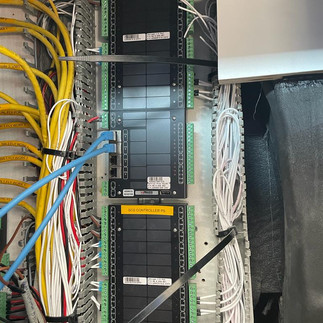Commissioning Our Explorer Yacht Control System
- Chris Leigh-Jones
- Oct 14, 2023
- 4 min read
Updated: Oct 19, 2023
Today, we're diving deep into a crucial phase of our latest project: commissioning our explorer yacht's systems. It's a meticulous process, filled with highs, lows, and plenty of steady progress in between. From testing the communications and marine ethernet to fine-tuning the navigation gear, every moment is a step closer to realizing our dream of a high-latitude sailing vessel.
So, whether you're browsing ocean yachts for sale or just fascinated by the world of maritime exploration, grab your sailor's cap, and let's dive right in!
Everyone who ever built a yacht will experience many highs and lows along the way. Those are the memorable instances, but between them lies the humdrum of steady progress. That is where we found ourselves this week, so I'll recap.
Communications and marine ethernet
Vanguard has a commercial-grade monitoring and control system from Praxis automation. Control is limited to engines, steering, and lighting, though most other things are monitored in some fashion.
The backbone of this system is a dedicated and redundant Ethernet, the big brother of a more familiar NEMA 2000 CAN. Ethernet runs between a number of discrete Input/Output gateway and/or ruggedized PLC's to operate various machinery. One of our first actions after launching was to test the integrity of the data communications system, and with luck, Praxis engineers were already in Antalya at the Damen Shipyard. Our first-off installation was about 90% correct, with a few missing connections and one physically broken. An easy one-day fix all around. We also powered up the 24VDC and 240VAC systems to confirm control and navigation gear power. A first cation here was a sniff test, overheating plastic insulation is quite distinct! Once we are fully powered up all connections can be checked with a thermal camera, for now, a nose is good enough.
Furuno Nav gear
We have contracted a single company (OMS) based in the shipyard to supply and install all Furuno navigation equipment with the exclusion of our large X Band radar arrays supplied by Praxis. It is often cheaper to split a purchase like this into parts sourced by price from many suppliers.
Having watched OMS spend three days connecting and commissioning everything, I'm glad we took the route we did. We now have functioning AIS(A), GPS, Sat Com, Fluxgate, Navtex, Sonar, Weather Station, Sat C, Irridium, VHF Radio's, Starlink, Pepwave ......
Grab handles
Appreciating a physical feature from a simple two-dimensional drawing is often difficult. With that in mind, we fabricated six small grab rails before launch. Once on the vessel with a moderate roll, finding the locations where we needed additional security and preventing the crew from gaining momentum between handholds was easy. The principal being that the lifelines should not act as the first line of defense for a stumbling crewmember. Five rails were secured in such strategic areas, leaving one spare.
Fuel system
Fuel is a subject that brings some considerable risks for the more remote locations. Specifically bunkering contaminated fuel will play havoc with any filter system.
To encourage good fuel husbandry we decided that all fuel being transferred would also be polished to the particulate specification as inlet to the John Deere engines. Filtration efficiency is one measure but there is also the need to retain capacity as they block.
The answer here was to select Cummins Fleetguard duplex filtration system as this has a considerably higher capacity (150g/h) than the more typical and equally efficient Racor filters used in similar installations. It's not a low cost option but it does make life more simple going forward.
Any reader wanting a great and practical explanation of fuel filters I'd recommend to Tony Athens of Seaboard Marine HERE.
Stability
Lastly, we move on to stability. Vanguard had no fuel or ballast in her hull when launched. The roll period was about 9 seconds, with quite a severe list at the extremities. Her design has water ballast compensation as we consume fuel on passage. Our first action was to fill 4.2T of water in the FWD water tanks. Once these tanks were pressed full, the roll period reduced to about 7 seconds, though we still have some way to go. From Gerr's book on stability (our Bible in this instance), our target is 1-1.1 times the beam, so 5-5.5 seconds. I'd like to understand some subtleties within this better, but that's the simple version. So now the task is to fully understand her "lightship" stability before proceeding further. A minimum 20% fuel reserve would put an additional 2t of fuel in the center tank, so there is plenty of scope to further bring that 7 seconds down. Looking at the draft, we also have the capacity for some permanent ballast up forward, making those FWD water tanks more useful than just for ballast, as we will not need to keep them full.
Onwards and upwards as the saying goes.
Chris Leigh-Jones
I recently had occasion to bump in to shipmate from some 40 years past. Our families shared a common heritage in part as they had involvement with the same ships, two generations ago. SS Elidir, named after a Welsh mountain was my paternal Grandfather's favorite and last berth. Coal fired, triple expansion engine, oil lamps..... How the world has changed in the course of just two generations.



























We have a few weeks yet until the sea trails start and our project becomes real. I've been sharing my own education in the hopes of shortening the learning curve for others rather than displaying how much is already known. Often it's as new to me as a new born baby. Thank you for your kind words, this sort of feedback makes it all worthwhile! Chris
Truly excited to see the next stage 'Sea Trials'.
I have really enjoyed following your progress though the build, thank you for sharing.